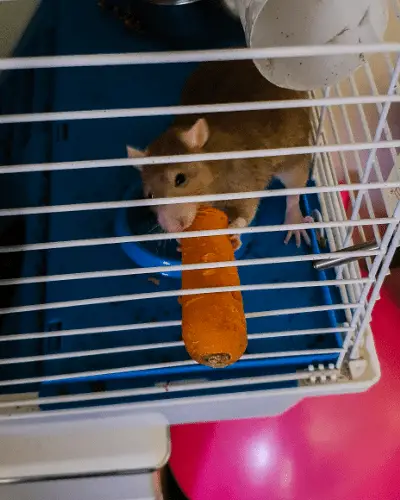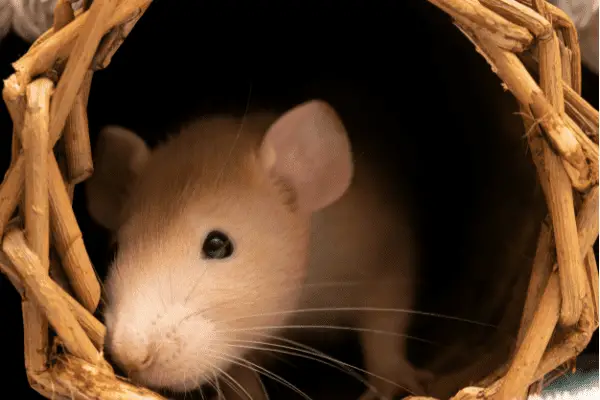This article contains affiliate links, and we may earn a commission at no cost to you if you choose to purchase through these links. I never recommend products that I do not trust or will not advise my veterinary clients and patients to use.
Rats have an exceptional talent for chewing; in fact, the word ‘rodent’ is derived from the Latin word ‘rodere,’ which means to chew or gnaw.
All rats need to have access to material to gnaw on. Providing appropriate and safe chew toys and ensuring that your rats are appropriately exercised and stimulated every day will help reduce unwanted chewing behavior. Some health conditions may also lead to abnormal or excessive chewing.
We may not be able to stop our pet rats from chewing everything in sight, but there are a few things we can do to help avoid the unnecessary and potentially costly destruction caused by our little critters.

This article will look at the common reasons why rats want to chew on everything and provide a few solutions to appropriately manage this instinctive but potentially nuisance behavior in our pet rats.
Why Do Pet Rats Chew On Everything?
Rats’ teeth will keep growing all their lives – almost like human nails or the hooves of horses and cattle. This is called hypsodont teeth and means that rats instinctively enjoy chewing and need to chew to wear down their incisors to prevent overgrowth and potentially painful dental conditions.
Chewing and gnawing is an important instinctual and necessary behavior for rats. Thus, rats who are unable to chew and gnaw may not only end up with painful dental conditions due to overgrown teeth but will likely show behavioral abnormalities associated with frustration due to being unable to express normal behavior. Examples of behavioral abnormalities include chewing their fur or constant pacing in their enclosure.
To follow are a few factors that will lead to an above-average increase in chewing behavior.
Age
Young rats are more inclined to chew everything in sight than older rats. The good news is that most rats will at least reduce their propensity to chew on everything as they age, provided that they have sufficient environmental enrichment and do not have other underlying medical conditions.
Gender
Female rats have a propensity to chew more than male rats do. This is likely due to their instinct to find bedding material and build nests for their young.
Lack Of Environmental Enrichment, e.g., Boredom or Frustration
Rats who are bored, lonely, or unable to express natural rat behavior will become frustrated and prone to stereotypical behavior such as constantly gnawing their cage, chewing fur, or pacing.
As rat owners, we need to take natural rat behavior into consideration to ensure our rats’ welfare and happiness. Sometimes it’s easy to forget that they did not ask to become pets or to be confined by humans, so it is our responsibility to make sure that their every need is met, even if it may be a slight inconvenience to ourselves.
Rats need a few basic things to be happy:
- A space to feel safe such as a nest or bed where they can hide
- Cage mates or access to other rats. Rats typically do not do well when kept alone as they are incredibly social creatures.
- Space to roam, explore and climb to keep them fit
- Access to a varied and balanced diet and clean water
- An environment where they can be free from stress most of the time
Suppose a rat’s lifestyle is void of one or more of the abovementioned points. It may result in boredom or frustration, leading to an uptick in stereotypical or chewing behavior.
Allowing your rats supervised free roaming time in a rat-safe space is probably one of the most effective ways to help fight off boredom and allow them time to exercise, which can be extremely helpful in reducing chewing due to frustration.
If you would like to read more on how to let your rat spend time outside of their cage safely and how often they need free-roaming time, have a look at this article.
Likely, this will mean that you will have to find an utterly rat-proof area and provide them with appropriate chew toys (details to follow) and obstacles or hideouts while they spend time in the free-roaming area. The safest place may be a large metal cage, a thick wooden crate, or a bathroom for severe chewers. Either way, the change of environment and the larger area will give them the needed stimulation.
If you think that your rats may be showing signs of stereotypical behavior due to stress, you might find my article on how to help a stressed pet rat helpful.
Health conditions
In some cases, an underlying medical condition may be causing your rat’s excessive chewing. Conditions that may cause excessive chewing include some dental conditions, endocrine conditions, and rare cases of pituitary tumors.
If you suspect that your rat chews excessively or there is a change in their chewing behavior, a visit to your vet is indicated. As a rule, your rat needs to be examined by its vet at least every six months. If you would like to read more on when you need to take your rat to the vet, look at this article.
Do Rats Swallow Everything The Chew On?
No, rats do not swallow everything they chew on. Instead, rats have check pouches separated from the rest of their digestive system (the back of their mouth and esophagus) by a membrane that can be voluntarily controlled. If rats are chewing non-food items, it is collected in a separate area in their mouth to spit out later. This is how rats gather bedding material to build their nests with.
Thanks to this nifty practical design of nature, we can do not have to worry too much about rats ingesting pieces of plastic or other hard material, causing a digestive obstruction. However, we still need to avoid our rats having access to any potentially toxic material as not all toxins need to be swallowed to be harmful.
How Do I Stop My Pet Rats from destroying everything?
1. Free-Roaming Time and Excercise
We already discussed environmental enrichment by allowing free-roaming time earlier in this article. This is probably the most effective way to reduce unwanted behavior due to a lack of environmental enrichment. For a quick guide on the basics of free-roaming time, please have a look at this article.
2. Provide Chew Toys
What rats like to chew on varies significantly from rat to rat, so take a few clues as to what substrate your rat prefers chewing on or offer them a few of the suggested materials below to hopefully distract them from chewing non-chewing objects.
- Soak wood blocks (willow, birch, maple, or any other fruit tree is typically safe) in apple juice and place them in their cage.
- Instead of chopping crunchy vegetables into bite-size chunks, hang large pieces of veggies such as carrots, broccoli, or corn on the cob from a string in their cage.
- Wrap pieces of tissue around a twig or piece of cardboard and place them in the cage as a toys.
- Nylabone is a meat flavored dog chew toy that some rats enjoy equally as their canine counterparts.
- Rawhide – check for non-toxic, pet-safe options. I know of a few rats who go crazy for Pet ‘n Shape All-Natural Chicken Hide Twists Dog Treats.
- Smear some peanut butter on the inside of a toilet paper roll.
- Plastic beach toys are a great choice if your rats enjoy chewing plastic. This plastic sandcastle toys can be a good toy for chewers who like to chew their way through plastic hideouts.
- Wooden and rope parrot toys such as this one, will be fantastic chew toys for rats who like to chew rope.
- Greenies Dental Chews such as the Blueberry Teeny Dog Chews are also a great option for rats.

3. Use Bitter tasting chew deterrent
Mouse and Rat repellent spray such as this natural non-toxic spray may be a good option to use in the free roaming areas if there are wooden or plastic objects that you do not want your rats to chew on.
Peppermint oil has been used as a natural rat deterrent for centuries. You can try rubbing peppermint oil on unfavorable chew toys to see whether this trick applies to your rats.
In my experience, apple bitters never seem to work and may even encourage chewing by some rats so unfortunately, it does not seem to have the same effect on rats as it does on dogs.
4. Chew Proof Cage
If your rat likes to chew plastic, you will have no option but to invest in a good rat-proof cage. The Critter Nation cages are chew proof and definitely worth the investment if you own a few viesty chewers!
Conclusion
Rats will be rats which means that you will never be able to prevent chewing completely. The best you can do is provide them with appropriate material to chew, make sure they are entertained and exercised, and to avoid access to anything you do not want them to chew on. The only foolproof way to avoid expensive damage to your belonging by chewing rats is to completely rat-proof the spaces your rats use. This often means wire mesh and hard flooring.
As a rat owner, you will have to be prepared to lose a few hammocks, food bowls, and other cage accessories due to chewing.

References
- Abdulai-Saiku, S., Hegde, A., Vyas, A. and Mitra, R., 2018. Effects of stress or infection on rat behavior show robust reversals due to environmental disturbance. F1000Research, 6, p.2097. https://www.ncbi.nlm.nih.gov/pmc/articles/PMC5782406/
- Banks, R., 2013. Exotic small mammal care and husbandry. Hoboken: John Wiley, pp.81 – 92. https://onlinelibrary.wiley.com/doi/book/10.1002/9781119265405
- Meredith, A. and Redrobe, S., 2002. BSAVA manual of exotic pets. 4th ed. Quedgeley: British Small Animal Veterinary Association, pp.13 – 25. https://www.researchgate.net/publication/240493099_The_BSAVA_Manual_of_Exotic_Pets_4th_edn
- Simpson, J. and Kelly, J., 2011. The impact of environmental enrichment in laboratory rats—Behavioural and neurochemical aspects. Behavioural Brain Research, 222(1), pp.246-264. https://www.sciencedirect.com/science/article/abs/pii/S0166432811002890
